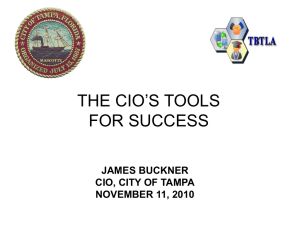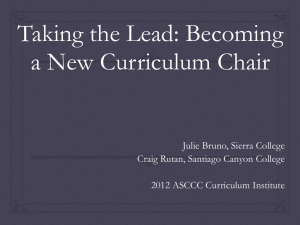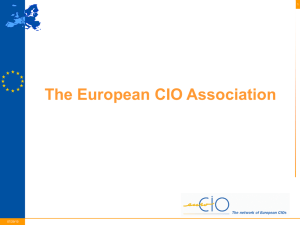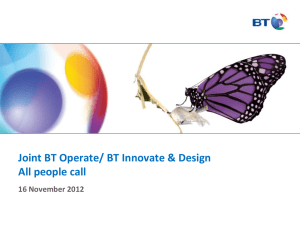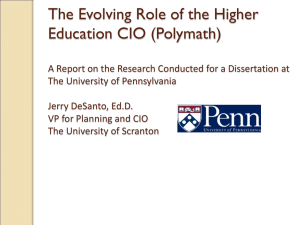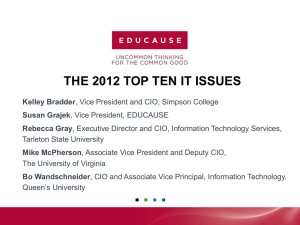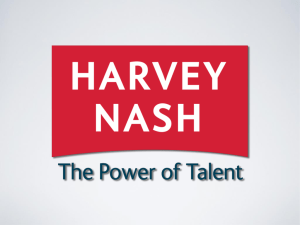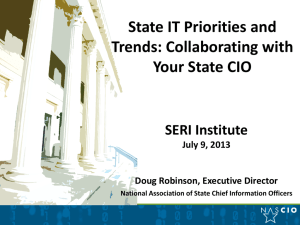positing_learning_technologies_in_higher_education
advertisement
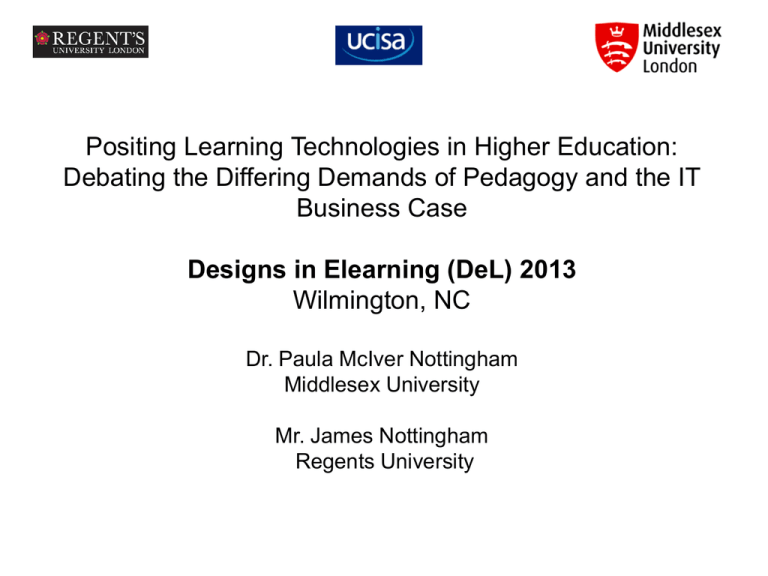
Positing Learning Technologies in Higher Education: Debating the Differing Demands of Pedagogy and the IT Business Case Designs in Elearning (DeL) 2013 Wilmington, NC Dr. Paula McIver Nottingham Middlesex University Mr. James Nottingham Regents University DISCLAIMER: the two presenters are using their draft work on UCISA’s Social Media Toolkit to stage a mock debate that relates to how staff in universities might view the use of social media. The role-playing positions are: the hard-working conservative and enterprise-centered CIO whose job is to ‘protect’ the university the hard-working innovative student-centered academic whose job is to develop learning capabilities and employability skills DEBATE – MAKING THE CASE CIO •Higher Education •Learning and Teaching •Customer Service •Infrastructure •Framework – planning •Institutional policy •Information governance protecting university •Decision making •New technologies – including social media •Supporting learning •The business case ‘Come back to me with a business case.’ Practitioner • • • Exciting possibilities to engage students necessity for 21st century learner Use of pedagogical theory Using flexible learning practice to create learners who incorporate social media skills for employability during their university education ‘Do you understand what I’m trying to do?’ What do I know? A Framework Information Governance The Executive COO Information Systems Service Group CIO & HoD ITS Senate CIO/Deputy CIO CIO Senate Student Affairs Committee Deputy CIO & HoD ITS Senate research Committee Deputy CIO College Professional Services Group Deputy CIO & HoD ITS Senate Academic Affairs Committee Deputy CIO & HoD MIS Learning Resources Committee Deputy CIO Office of the CIO Chief Information Officer Management Information Services Learning Resources Information Technology Services Faculty Learning & teaching Committees Deputy CI0 Better Regulations Group HoD MIS Senate Academic Development Committee Deputy CIO & HoD MIS New Learning Opportunities Supporting Learning The Learner & The Academic The Business Case •Clear links to strategy & Plans •Keep it simple! •The value proposition •Fully costed •Options analysis •Net present value •Easy to do •BA’s SA’s et al… ‘Come back to me with a business case.’ The business case? http://paulanottingham.blogspot.co.uk Centre for Learning and Teaching = ALEX - Moodle Following government policy for academics – E-learning (HEFCE), JISC + HEA. The guidance is to incorporate digital technologies into learning (including social media). •‘A Practical Guide to Providing Flexible Learning in Further and Higher Education’ that “the ‘value’ in flexible learning is in the teaching and interaction with students and creating the right conditions in which they can learn” (Casey and Wilson, 2005, p. 3). •In a blended learning environment communication is now carried out through multi-modal conveyances (Jewitt, 2009). Pictures and words – sometimes pictures, audio or audio visual come first (the written word may not necessarily be privileged anymore in communication). Digital literacy – what does it mean for students using Web 2.0? Learning in a ‘disruptive’ environment Christensen, Clayton M. (1997) ‘The innovator's dilemma: when new technologies cause great firms to fail’. Explained two stereotypes of disruptive innovation: “Low end disruption” occurs when a simpler, cheaper and lower-performing offering that still meets customer needs enters the market and undermines ostensibly more sophisticated offerings.” “New market disruption” occurs when an innovation enables a new or emerging market segment that is not being served by existing incumbents in the industry.” (observatory.jisc.ac.uk) Pedagogical models exist but using these models can mean changing conventional content-led approaches. Barnett (1999) realizing the university in an age of ‘supercomplexity’ creating an environment that is appropriate for learning in higher education Brabazon (2007) The University of Google Siemens (2005) connectivity Conole (2010) working with cloud technology Solomon, Boud and Rooney (2006) everyday learning at work Argyris and Schön (1974) ‘espoused’ theories and ‘theories in use’ to examine existing practice AND POLICY. Do you understand what it is that I have to do? REBUTTAL CIO • Yes I understand the needs of the end user – ideally the the tools are available behind the firewall where it is safe via VLEs and tech enhanced tools (this is informed by the L&T staff) – IT policies generally say that you should work within the confines of the enterprise • Protecting the university entity by assuring government’s data protection and quality assurance procedures - QAA • Planning is an18 -24 month cycle • Cost implications of engagement • The new CIO – a change in management Practitioner • So provision is based on the policies of the corporate entity but the options for student-centered learning need to be taken into consideration by IT related policies for academic work • Student life is very fast-paced and social media technologies keep up with that way of working, it is the academic who needs to facilitate and inform how students think to promote academically sound engagement with social media. • Students working exclusively behind a firewall may may not understand current business practice Decision Making Workflow The Executive Strategy & Plans COO The Executive & Trustees Institutional Resources The Faculties Groups & Individuals Business Proposals v CIO Support Departments Supporting Innovation Faulty Projects Office of the CIO Supporting the Business Chief Information Officer Management Information Services Learning Resources Information Technology Services Innovation Business Case Decision Making • The ‘new CIO’ negotiates between the enterprise and the academics • A combined service structure • The plan is ‘live’ • Decisions to be taken by the CIO • Cost benefits Making a Difference Developing practice that uses social media •as a way of communicating •developing digital literacy that appreciates the private/public issues as a point in the learning process – fluency and responding to change •ethical aspects of learning in a Web 2.0 and beyond Martin Weller The Digital Scholar Diane Laurillard Teaching as a Design Science Salmon (2003) E-tivities Practitioners and students are providing an argument for working with social media within higher education. Sources upon request. CLOSING REBUTTAL CI O Okay, that’s why UCISA is doing the Social Media toolkit to give IT leaders clear guidelines for their institutions. Practitioner Okay, I get it. It would be good for everyone to understand that I am developing pedagogy based on the needs of the students. I think there needs to be a clear link between the IT department, the L&T central staff, and the academics for best practice. Maybe the UCISA toolkit will provide an inclusive template that benefits practitioners. Points of view from the floor…
